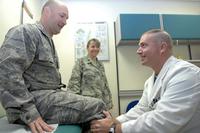Once again the subject of increasing TRICARE costs has hit the news – the latest proposal being offered by the bipartisan Debt Reduction Task Force, co-chaired by former Republican Sen. Pete Domenici and economist Alice Rivlin.
One of the stated goals of the bipartisan task force is to reduce the cost of military health care by imposing greater cost-sharing on TRICARE beneficiaries. The rationale is that the program was originally designed so that retiree’s premiums would cover 27 percent of the total cost of TRICARE. The program fees have not increased since TRICARE replaced CHAMPUS in 1995; in today’s dollars retirees are only covering 11 percent of the program cost.
The task force report states that active duty personnel and their dependents use less than half (42 percent) of TRICARE’s total cost, pay no premiums or co-pays. Thankfully for this group, the Task Force decided to focus “exclusively on retirees and their dependents, for whom benefits have expanded without a significant change in cost-sharing.”
The task force report lays out a plan that would raise working age retiree premiums, cost-shares and co-pays so that working-age retirees would once again cover the 27 percent of TRICARE costs as was part of the original plan. Increasing the fees seems to make sense from a purely economic point of view.
In addition, Medicare-eligible retirees using TRICARE for Life as a supplement to Medicare would be required to begin paying “minimal cost-sharing” amounts under the plan. Based on the language of the report this cost-share increase is to “maintain equity among retirees – both between different cohorts of military retirees and between military and the wider community of seniors that also faces higher costs.”
Some retirees could see their TRICARE premiums increase by as much as $2,000 a year. Tom Philpott recently offered a glimpse at what future premiums, cost-shares and co-pays would look like based on the panel’s suggestions. (Read: New Panel Targets Retirement and TRICARE)
- A married retiree with less than $20,000 in annual retired pay would pay $730 in year one, $900 in year two. These larger incremental raises would stop in year five when the yearly fee would hit $1260 an increase of $800 a year.
- Those with retired pay of $20,000 to $40,000 would pay more. The highest enrollment fees, for those drawing more than $40,000 in retired pay, would top off in year five at $2460, or $2000 more than they pay now.
- Fees for outpatient visits would more than double, to $28.
- Working-age retirees using TRICARE Standard plan or TRICARE Extra would be charged an enrollment for the first time of $150.
- Pharmacy co-pays in TRICARE retail network – now $3 for generic, $9 for brand-name drugs on formulary and $22 for non-formulary drugs - would be reset at zero for generic drugs, $15 for brand names on formulary and $45 for brand names off formulary.
View current TRICARE Cost Schedules
It seems each year the subject of increasing TRICARE out-of-pocket expenses comes up, and of course ensuring TRICARE sustainability is vital. But the members of so-called debt reduction panels need to remember that eligibility for TRICARE benefits is not based on age, income, or employability – these benefits are earned through service and commitment to our nation’s defense.
Be sure to read about Congressman Steny Hoyer's desire to freeze military pay.
Let the DoD and your elected officials know how you feel about these cost cutting proposals.



